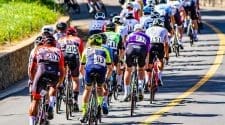While training for a big event, it’s all too easy to overdo it and accidentally overexert yourself. This is why proper recovery after a long ride is essential to keep your body in tip-top shape so you can safely continue your training.
Many cyclists make the mistake of cutting corners when it comes to their recovery. Their goal is to squeeze in as many miles as possible without giving their bodies adequate time to repair the damage. During training, you are putting your body through a considerable amount of stress and breaking down your muscles. It is during the recovery period that your body rebuilds those muscles, making them stronger and increasing your endurance. By skimping out on your recovery time, you are putting yourself at a higher risk of injury, which could delay your training or even make it impossible to compete altogether.
Fortunately, recovery doesn’t have to be complicated. Following just a few simple steps will help your body rest, recover, and heal so you can get back on your bike rejuvenated and stronger than ever.
Stay Hydrated
Before reaching for that beer or coffee mid-ride, it’s best to opt for water or an electrolyte beverage first. Generally speaking, most cyclists will go through one bottle of water for every hour they’re on the bike. However, this is subject to change depending on your exertion level and how hot it is. If you’re sweating more than usual, it’s best to bump up that amount and drink a sports beverage that contains carbohydrates, electrolytes, and sugars to help your body absorb the fluid more easily.
Elevate Your Legs
During an intense training session, fluid will often collect in your legs and cause swelling. To combat this, lay down on the floor with your legs up against the wall to help drain that fluid, reduce swelling, and give your hamstrings a great stretch to kickstart your recovery.
Refuel With Protein and Carbs
Proper nutrition is the key to recovery after a long ride. Fueling up with carbohydrates will restore your energy levels and replenish your glycogen stores, while protein will help repair your muscles and reduce soreness. A plant-based diet could help improve your recovery time thanks to its abundance of carbohydrates, antioxidants, and phytonutrients. A plant-based diet is also anti-inflammatory, which supports recovery by reducing muscle soreness and damage. This doesn’t mean that you have to be 100% plant-based to reap all of the benefits. However, building a nutrition plan that is rich in plant-based foods will supply your body with the nutrients it needs for a quick and effective recovery.
After a strenuous race or training session, it’s important to listen to your body. Some cyclists opt for an active recovery by doing gentle exercises such as walking or mobility work, while others choose to simply stretch or do some self massage. Whichever form of recovery you choose will depend on your own unique needs, goals, and level of exertion. As long as you give yourself ample time to rest and recharge, you’ll reduce your risk of injury and be prepared for your next big ride!
Image by Brent Olson from Pixabay
No products found.
















